Anatomy Of A Painting By Bill Schultz
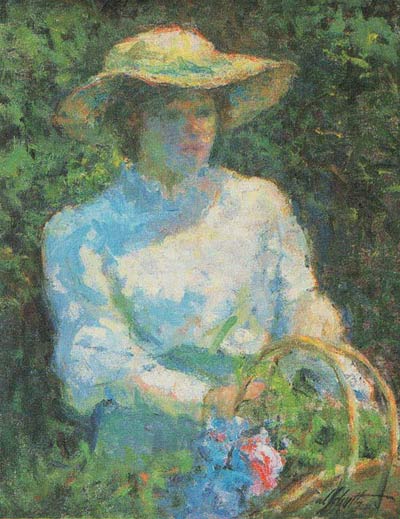 Once, as I was ranting about one thing or another in my own class, I heard a student say to another with a touch of dread in her voice, “Geez, you have to be so pure.” No you don’t. Perhaps if this student could have only heard Bill speak as she watch him paint, perhaps then she would have gotten the feeling that my ranting could not instill: it’s all about becoming “larger, more powerful, more beautiful” (to borrow Emma Goldman’s phrasing).
Once, as I was ranting about one thing or another in my own class, I heard a student say to another with a touch of dread in her voice, “Geez, you have to be so pure.” No you don’t. Perhaps if this student could have only heard Bill speak as she watch him paint, perhaps then she would have gotten the feeling that my ranting could not instill: it’s all about becoming “larger, more powerful, more beautiful” (to borrow Emma Goldman’s phrasing).
Being lifted up, getting into that magical place where it all comes together, where one does indeed feels larger and more powerful – forget the painting – is not about purity; it’s about being free. Bill’s way of saying the same thing might be a little less elevated, but more to the point: “From the first stroke to the last, be an artist.”
So let’s take a look at a demo he did, the painting above. I’m guessing but I would say this painting of a model out of doors was probably about 30 x 24 inches. And he probably worked on this during a two and a half hour morning class, which included a break or two. Below is a close-up of the head where I have marked several areas for analysis.
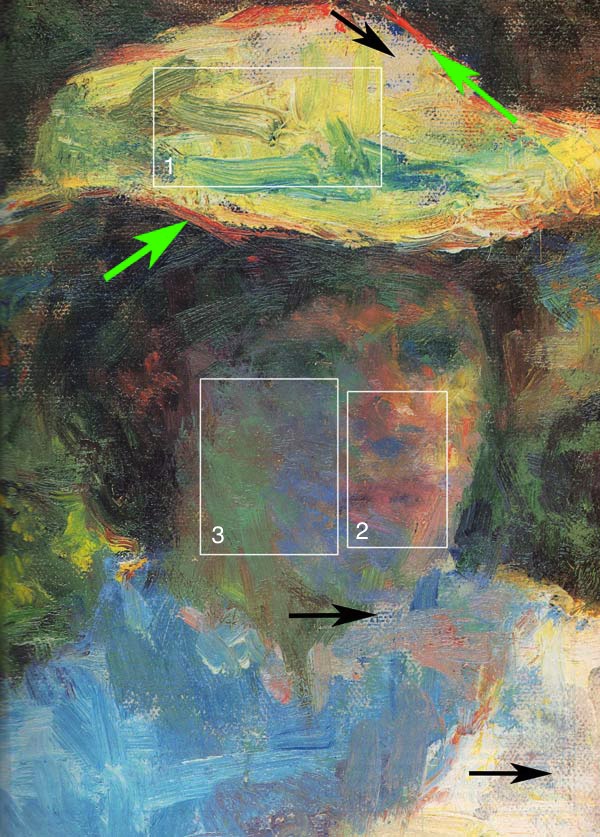
First, note the black arrows. They are pointing to areas where the canvas is coming through. If you look closely you will find many more. The idea here is that a painting is a series of layers, one above the other. One begins with the ground, which in this case was a white canvas, probably slightly tinted warmer to drop it down in value just a touch and also so that the tint color would correspond to the atmospheric color of the day. On top of that would be the underpainting and on top of that would be the painting. The underpainting does not cover all of the canvas, nor does the painting cover all of the underpainting. This means that one can peer down into the layers and in some instances the canvas itself, or ground can be seen. This way the painting breathes as opposed to being “plugged up.” Look again at the work of the French Impressionists and you will find that most employed this way of getting a feeling of freshness and life from their work.
Second, notice the green arrows. They are pointing to a kind of red-orange line. This is called a prismatic edge. When there is a dramatic break or separation of values, our retinas can’t quite handle the sharpness of the separation and we see a glow of color on an edge. This helps the thing turn. Prismatic edges aren’t always the same color. And please – this gets back to the purity issue – do not make them up. You must see them and to see them you must feel them – this gets back to the feeling larger issue. And while we are going down this road, if you paint from photos, you will never see prismatic edges nor feel them. I could say the same for many other visual elements. If you wish to work in this tradition, don’t work from photos: they positively stunt your growth – unless you are off on some other dimension of which I am not aware.
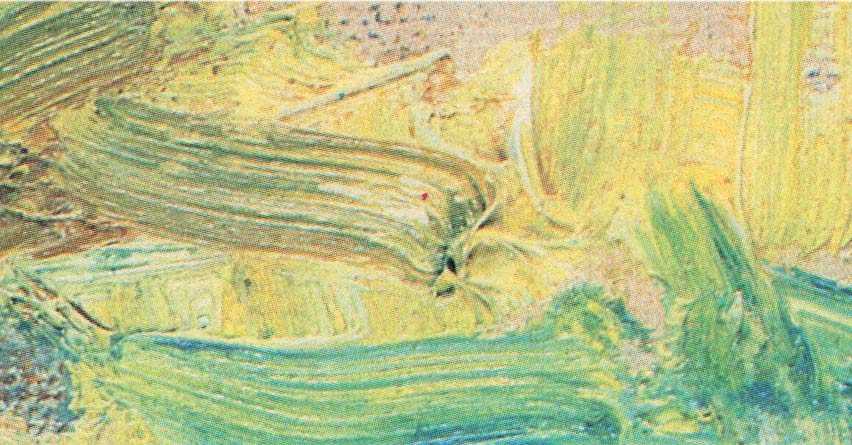
The image above and the next two images are taken from the same painting. First, let’s look at the image above (detail 1). What do we see? We see that someone, using a brush, in a burst of feeling, has applied paint to a canvas. The paint is in the light so it is somewhat impasto or thick. It is done with authority and expression. As Bill put this stroke of color down – releasing the color as he would say – he was not trying to make a hat. He didn’t even see a hat. He is responding to the sensation of bright light, getting a feeling, making the stroke in a beautiful authentic squish and as he does that, in the very moment that he drags his brush across the canvas, he realizes yet another feeling that lifts him up, makes him feel larger. This is why he paints, not for the results, the painting. That is a by-product. He paints so that he can exercise his capacity to see and touch and in the process, in the moment of creation, he becomes more Bill. That’s the payoff. That’s what painting is all about.
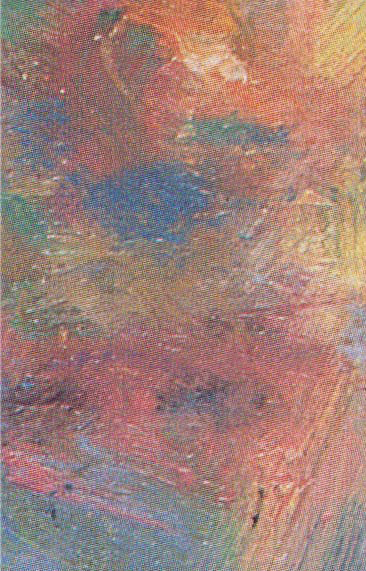 If we look at the image on the left (detail 2) we can see the same approach. If you saw only this image you would not know that you are looking at a nose and a mouth, and that’s the point. As Monet would say, don’t see noses and mouths. See color. That is what is going to move you, not someone’s nose or mouth. The rush comes not from reading with your eyes but tasting with your eyes. And as with the hat detail above, the nose and mouth are painted, not drawn with the color. This is what a painting is, a notebook of feelings for that time where you were captured by what you saw. Notice I did not say that you captured X, Y, or Z – the beauty of the lake, for example. It’s the reverse: the beauty of the lake captures you.
If we look at the image on the left (detail 2) we can see the same approach. If you saw only this image you would not know that you are looking at a nose and a mouth, and that’s the point. As Monet would say, don’t see noses and mouths. See color. That is what is going to move you, not someone’s nose or mouth. The rush comes not from reading with your eyes but tasting with your eyes. And as with the hat detail above, the nose and mouth are painted, not drawn with the color. This is what a painting is, a notebook of feelings for that time where you were captured by what you saw. Notice I did not say that you captured X, Y, or Z – the beauty of the lake, for example. It’s the reverse: the beauty of the lake captures you.
Finally, if you saw nothing but the image below (detail 3) I doubt that you would know that it was someone’s cheek. And again, the reason is because Bill did not see a cheek; he saw color and, therefore, he got the cheek “through the color.”
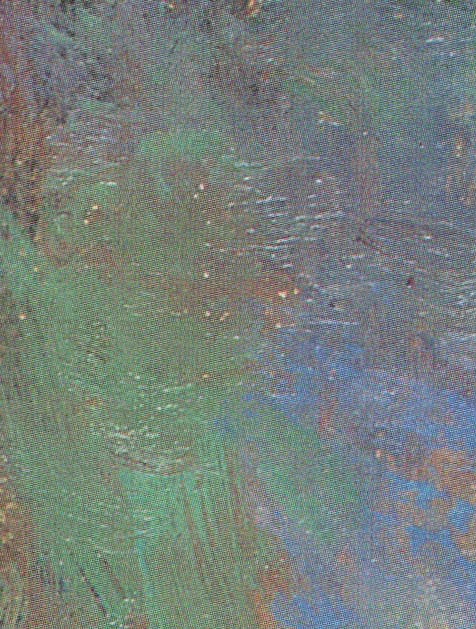 But notice also the colors he saw: basically blues and greens with what appears to be some underpainting coming through. One can only do this if:
But notice also the colors he saw: basically blues and greens with what appears to be some underpainting coming through. One can only do this if:
a) one is not looking for results as one paints; otherwise, one would make a “cheek”.
b) one is not painting for a competition or gallery or to please someone (all of which Pissarro called “external” measures); otherwise, one could not be “free…to be himself” (again Pissarro) or herself.
c) one is not painting from a photo; otherwise, one could not feel and see atmospheric color.
Feeling “larger” during and because of the creative process is the name of the game. The painting just happens along the way.
23 Comments
Address
Via Teresio Olivelli, 20
22021 Bellagio (CO)
Italy
+39 338 975 7135
Open Hours
Tuesday - Saturday: 11:00am – 6:00pm
Sunday - Monday: 1:00pm – 6:00pm

Hi Jerry: At the current time, I am not able to take any workshops or get together with other artists in areas that have paint thinner. I am painting with water soluble oils and after some practice, am doing pretty well with them. I am on oxygen 24/7 but am doing really well. All this means is that your newsletter is even more inspirational than ever and I also enjoy your YouTube demos as refreshers. I am still able to travel, so maybe a day or two of private lessons is in my future with you. I can just strap my plein air easel, etc. to my portable oxygen and come on over. Hi to Conchitina
Hi Linda, Nice to hear from you. I hope to be making some instructional videos soon. Anyway, hang in there and please
as questions with regard to your work if you want; or we can hook up via Skype and have a look-see conversation.
I’m glad to see you can get around with your oxygen and I suspect you are doing marvelous work based upon what I have
seen in the past…hang in there, the future looks bright. J and C (poor ole Lupo died at 20 about a year ago!!)
This is great Maya! What fun! I’m totally going to set up a caanvs and paint along with you!!!! You rock, keep up the great and inspiring work!!!!!!!!!!
Jerry, this is one of the best written, most well-explained articles that I have ever read on painting. You inspire at every turn – on the feeling and heart of the artistic process and I’m grateful to have “met” you.
I’m super interested in those prismatic edges. I do understand having to feel them and they just do appear. I’ve never heard it described that way before – for me, it’s always been a very spiritual place in the painting – an area where the “things” somehow cease becoming what they are and leak a little of their spirit into the next “thing”. I love this thought of connectivity – it’s definitely my drug.
Thanks Janice. Glad you liked it. Bill was great and I could go on and on about his work and his teaching. Maybe I will do it again with another work of his someday. Regarding prismatic edges: 1) you really have to see them and if you don’t, don’t worry….just look for them and they will pop up every now and then; 2) go easy…..nothing is worse than a bright line that doesn’t work…..so here’s a hint: because the color happens when there is an abrupt separation between something dark and something light, the prismatic edge is part of the dark!! that is, it fits into the separation on the dark side! J
enjoyed article–about brushstrokes and red orange line
reminds me of Wayne Thiebaud–cake paintings , outlined with rings and rainbows of pure color-bright blues/reds/purples register at a distance only as a just -perceptible vibrato. He began by “drawing in color” until the original
outlines peeked out from beneath.-Halo effect–W. Thiebaud–Nash and Gopnik
Interesting Jorge; I know what you mean. I doubt that Thiebaud was seeing those vibrato type lines but I would also guess that they are, indeed, base upon prismatic color. Once you see these things, you can go in any direction and Thiebaud is a great example. J
Great video Pete and a promising look at your enictixg techniques. I’ve been checking out your web site and look forward to when the videos are fully operational. thanks great work.again, your techniques are enictixg to watch, I’m hoping to put some to use in my work.
Really great lesson for any painter. Thanks so much for including them in your mail outs. I hope one day to join your workshop for a session as I’m sure I would learn much.
Thanks again and keep them coming sir.
Steve Paschal
Mililani Hawaii
Thanks Steve. Nice to hear from you. J
As a very sad neighbor of Hana’s, I aeripcpate how you captured the feeling. I did not know her, but am haunted by the idea that she was so close and yet so far. You have captured the haunting loneliness and isolation that she must have felt. Thank you.
Hi Jerry. Enjoyed the best explanation I have ever read and understood reference to the anatomy of painting.You have a special gift simplifying the art of observation, and not being a slave to the subject matter in front of you.Looking forward to more of your pearls of wisdom.regards new fan Larry
Thanks Larry. My bent is to get more into the philosophical side of things but I get more responses from the “how to” commentary. More practical I suppose. So I may do more. Of course, analyzing Bill’s work is a piece of cake and I could go on forever given that I studied with him for so long. Besides, it is worth pointing to a few things that so many people might miss.
Thank you so much. This is very powerful. Everybodys cenmomt and expression warms my heart. Thanks God there are so many caring and loving humanbeings around. We will outnumber the evil and bring justice for Hana Alemu.
Jerry,
I have very fond memories of my uncle Johnny, aka, Bill Schultz. He was a great artist and I was always impressed with how quickly he could put a painting down and get his colors and feelings so accurate. Thanks for explaining to others about his talents and gifts, not to mention the nicest artist I’ve ever known.
Thanks again,
Bud
Thanks Bud; it is very easy to sing the praises of Bill, as nearly all his students would agree. I often wondered what I would be doing and how different my life would be had I not met him. And I’m sure there are hundreds out there who would say the same. I could never figure out which he was better at, teaching or painting. He was amazing in both. But he himself said that while he could live without painting he couldn’t live without teaching. So I suppose that explains the impact that he had. He was one of the greats. No doubt about it.
I love your site and the way you describe the posecrs of making your artwork. Even though you planned to make it look like a particular flower and it turned out to look different than your plan, it proves that it is true art. Your final painting is beautiful.
Hi Jerry,
It’s been s long time since you helped me with my painting back in San Francisco. The lessons stayed with me, and helped my drawing, too.
Larry a Huggins
Larry – how are you??? Nice to hear from you. Glad you have stuck with it. Great. Say hello to your wife. Best to you both.
Jerry
Hi Jerry,
Bill Schultz is my mother’s first cousin. She always called him Johnny. They were close friends during their childhood and she collected his art as an adult. She is 100 now and most of her paintings are hanging in my house. She often talked about how hefirst learned to paint at the Boys Club in Pittsfield, MA back in the 1920s. So much fun to find this blog about his technique and his devotion to being an artist.
Thanks for writing this!
Best regards,
Jan Krause Greene
Hi Jan, So nice for you to write. Yes, I heard that his nickname was “Johnny” and he used to tell us how his Boy’s Club card cost only 5 cents for the entire year. Best to you. Jerry
Hi Jerry, Here is is 2018 and I just found your article on Bill. Bill was my teacher for many years. Janette Maloy and I sponsored several workshops a year in the Waynesville, Ohio area. Pauline Nye was also one of our attendees, and she and Bill later were founders of The American Impressionist Society. I also modeled for him on several occasions. His kind gentle spirit touched us all. I miss him very much. Thank you for your article. Kathy Kappeler Johanson.
Hi Kathy, Great hearing from you. Luckily I was born in Pittsfield and had studied with Bill
since I was 16. So he was a major, major influence on me – to say the least. I miss him!!